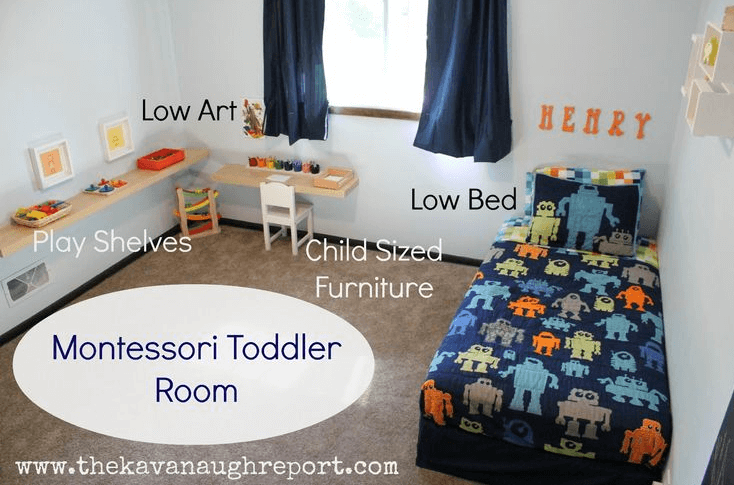“One of the brain’s major learning tasks is to organize the confusing array of sensory stimuli that start bombarding the infant at birth. For this, children need an environment over which they feel some control.” Endangered Minds – Jane Healy
My third grandchild is due in a few weeks; this is the first child for my son Elliott and his wife Danielle. Anyone who has experienced the transition from couplehood to parenthood will tell them, “Once that baby arrives your lives will never be the same”. I would add; once that baby arrives your home will never be the same either. To some this might mean your home becomes chaos and mayhem but I don’t think this has to be the case. In the next couple of paragraphs I want to share 5 ways that you can make your home a healthier place for your children.
As an interior designer, I have seen homes literally overtaken with kids’ stuff; living rooms, dining rooms, even bathrooms bursting with kids “toys”, accessories and screened gadgets. This is not exclusive to smaller homes, sometimes the larger the home the bigger the problem. Often our clients tell us that family and friends gave them these things and they don’t want to offend or disappoint them so they suffer with the chaos. In some families having it is a way of demonstrating love. In others it is believed to show security or affluence. Often the argument for keeping it is that it holds memories, the child loved it, or they are “saving it” for future children.
In our culture of consumption we are inundated with compelling reasons to believe that children need lots of “stuff” to learn or be entertained. Although I sense a shift, such as this inspiring post from Anna at thishouseisourhome.net. I believe there is still a journey of awareness to travel before we are living in homes that are healthier, calmer places for kids to do the important work of growing up. I would like to share with you a quote from the post on Anna’s blog that really talks to this concept:
“[Our Children] They need compassion, security, respect, Faith and morals to guide them; they need our love. They need our eyes on them as they show their latest skill, our ears open to hear their latest story, our minds and hearts fully present when we sit with them to play, to read, to be. In the end… that is everything they need. ” ~ Anna
So here are five ideas for creating a healthier place for you and your kids
-
Clear out the clutter – let things go.
The single most common thing we hear from our Good Space clients is: “I need more storage”. Followed by:
- “I want my home to be more organized”.
- “I want my home to feel more calm and orderly”.
- “The clutter is driving me crazy”!
- Or my personal favourite – “I just want to hide all this crap”!
It is not a great leap to conclude that if you feel this way so do your kids. Their expression of it might not be as articulate as yours but there is little doubt that they feel it too.
I believe that our attachment to “things” creates emotional clutter out of physical clutter. So I will break it down to organizing 101.
- Do you love it? Then find a place for it and a way to honour it.
- Is it useful to you? Then keep it and create a place for it.
- If you don’t like it, don’t use it, feel guilty about it, keep it because it was “expensive”, keep it out of obligation, (i.e.; “my mother gave it to me”; or the double challenge…. “it was expensive and my mother gave it to me”), acknowledge that it is hard to let “stuff” go.
- Imagine how much better it will feel with it gone.
- Do whatever you need to do to let it go. Chant, pray, meditate, donate, ask a friend to look after it for you… forever… but let it go.
Take a moment and ask yourself; Are guilt, obligation and attachment to “stuff “what I want to demonstrate to my children?
Idea: Make a game out of sorting and giving away excess toys to people they know or a cause that might excite them. The shoebox program is just one of many that allow kids to give to other kids. Check out this video of children in Madagascar receiving shoeboxes full of Christmas presents.
-
Encourage your children’s natural born generosity.
The essence of giving is that it makes us feel good. A study published by the University of British Columbia in 2012 shows: “that children are actually happier giving than receiving.” Do they need more “stuff” for their birthday or any special occasion for that matter?
Idea: Switch gift receiving occasions to gift giving traditions. On special occasions rather than receiving gifts, why not create opportunities for children to give gifts and experience the good feeling that comes from that?

My daughter Tyla and Grandson Ben with this year’s Food Bank donations Ben received in lieu of presents for his birthday.
Since my grandson Ben’s first birthday party, before he knew the difference, my daughter Tyla requested that there be no “gifts” instead she asked guests to bring food for the food bank. The tradition began that the day after his birthday party Ben and his mom take all the “gifts” to the food bank and Ben can see what a difference his birthday makes to others. The added benefits are that their family space isn’t full of dusty “stuffies” and plastic toys in addition to the lesson in generousity for Ben.
-
Limit the number of choices
Decision overload or decision fatigue is a real thing. The New York Times Magazine published an interesting article n 2011 ‘Do You Suffer From Decision Fatigue?‘. In the article there are numerous studies cited confirming that decision overload can affect the outcome of even the most simple everyday choices. Put simply, we have a limited capacity and energy for making well considered decisions before we start making bad ones through impulsive behavior. The proof of what it does to adults is pretty compelling; imagine how it might be for children with their natural drive to learn through experience to be surrounded by multitudes of toys, screens and activity options.
Idea: Out of sight is really out of mind. Keep out a limited number of toys or activities, preferably their favourites and put the rest away in a closet or chest. Make it a trade event when it feels like it might be time for a change.
-
Invite Maria Montessori into your home
Everything I learned about keeping my home and four kids organized I learned in preschool, really it was. I discovered the philosophy of Maria Montessori when searching for a preschool program for my kids in the early 1980’s. Her philosophy resonated with me and caused a dramatic shift in my point of view and how I created our home for our children.
Dr. Montessori had a graceful, respectful approach to the environment of children that is timeless, brilliant, inclusive and achievable. She believed in setting up the physical environment of children to encourage their success in all of their activities and endeavors or as she calls it “work”. Her methods include creating a place for everything they use at a level that is easily accessible to them. Training children is the challenging but worthwhile part. The key? Start early, and remember it is never too late if you are prepared to work a bit harder at it.
Idea: For small to large kids: install reachable hooks to hang up their own coats and bags and a designated place to put their shoes. For toys and games – create designated, accessible places that when they are done playing or working, can easily be put back where it belongs.
-
Practice saying no – or no thank you.
It is sometimes hard to know the difference between what your child needs and what you want for them, it is complicated to unravel that emotional process. In the her book, ‘The Conscience Parent’, Dr Shefali Tsabary says parents “fall into the trap of using our children to fill some need in ourselves, all the while under the illusion that we are loving, giving of ourselves, and nurturing. “ Saying no to gift givers, to your child and your own inner consumer is a practice. Like all practices you get better at it the more often you do it.
Idea: Take a genuine mindful pause before you buy something more for your child. Before you accept a “gift” or ask a relative for something for your kids, let a few thoughtful moments pass. Check in on your emotions, reasoning and motivation for the purchase or acceptance of a gift and be clear about the need and benefits to your child, and then decide.



